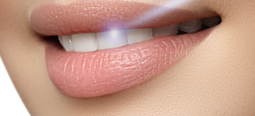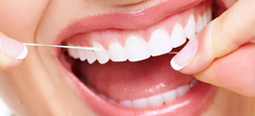
Lasers are put to a number of uses. With regards gum surgery, this treatment method is preferred as it has a number of benefits and advantages.
a) When lasers are used the surgeon does not require to cut into the gums using blades so that they can remove the diseased tissue. Using of blades involves cutting healthy tissue to reach the diseased tissue. This is not the case with lasers.
b) Laser technology helps in accessing all areas of the gums that need treatment. It does not affect the bones, teeth or even the healthy tissue. This is usually done by the differentiation of healthy and diseased gum tissue color.
c) As there are no blades and only diseased tissue is removed and treated, the pain and discomfort are lesser than other traditional methods of gum surgery.
d) The risk of complications is decreased as well as there are no blades used or other tissue which is affected. This means the recovery time is faster for the patient.
In addition to gum surgery, gum treatment also uses lasers for periodontitis. This is when various kinds of bacteria affect the gum. These bacteria are found in plaque that is usually collected on the gum line of the teeth. They then migrate following the root surfaces and they calcify there and produce tartar. This causes the inside lining of the gums to get ulcerated and inflamed. This if not treated in time can cause the periodontal tissues to be destroyed and this, in turn, causes the loss of the tooth.
Therefore, to arrest the disease, initial therapy is applied where the surfaces of the root are disinfected and cleaned and so healthy tissue can then grow in its place.
Traditional this consists of scaling or root debridement. This is done by hand instruments or sometimes even ultrasonic instruments could be used. This requires a lot of skill and a lot of time as well. This also consists of removing the pockets which are formed between the teeth and the gum tissue. However, this is not necessary as the tissues heal regardless of if the pocket lining is removed or not.
Laser Dentistry Dural technology replaces this therapy and gingival curettage is possible using it. It is also used to remove calculus as well as biofilm which is on the root surface. This, in fact, is a better method due to the following reasons:
a) There is minimal damage to the tissues and minimal swelling caused
b) There is much less bleeding
c) The area being treated gets sterilized
d) The post treatment discomfort is reduced
e) The patients are less scared and are more open for these procedures
These are some of the benefits of lasers for Gum Laser Treatment.
a) When lasers are used the surgeon does not require to cut into the gums using blades so that they can remove the diseased tissue. Using of blades involves cutting healthy tissue to reach the diseased tissue. This is not the case with lasers.
b) Laser technology helps in accessing all areas of the gums that need treatment. It does not affect the bones, teeth or even the healthy tissue. This is usually done by the differentiation of healthy and diseased gum tissue color.
c) As there are no blades and only diseased tissue is removed and treated, the pain and discomfort are lesser than other traditional methods of gum surgery.
d) The risk of complications is decreased as well as there are no blades used or other tissue which is affected. This means the recovery time is faster for the patient.
In addition to gum surgery, gum treatment also uses lasers for periodontitis. This is when various kinds of bacteria affect the gum. These bacteria are found in plaque that is usually collected on the gum line of the teeth. They then migrate following the root surfaces and they calcify there and produce tartar. This causes the inside lining of the gums to get ulcerated and inflamed. This if not treated in time can cause the periodontal tissues to be destroyed and this, in turn, causes the loss of the tooth.
Therefore, to arrest the disease, initial therapy is applied where the surfaces of the root are disinfected and cleaned and so healthy tissue can then grow in its place.
Traditional this consists of scaling or root debridement. This is done by hand instruments or sometimes even ultrasonic instruments could be used. This requires a lot of skill and a lot of time as well. This also consists of removing the pockets which are formed between the teeth and the gum tissue. However, this is not necessary as the tissues heal regardless of if the pocket lining is removed or not.
Laser Dentistry Dural technology replaces this therapy and gingival curettage is possible using it. It is also used to remove calculus as well as biofilm which is on the root surface. This, in fact, is a better method due to the following reasons:
a) There is minimal damage to the tissues and minimal swelling caused
b) There is much less bleeding
c) The area being treated gets sterilized
d) The post treatment discomfort is reduced
e) The patients are less scared and are more open for these procedures
These are some of the benefits of lasers for Gum Laser Treatment.
